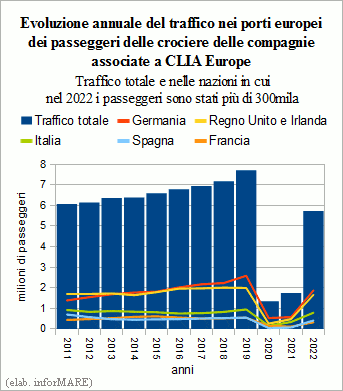
After the slow but steady and lasting growth that has led to the 2019 cruise companies associated with CLIA Europe, the section European Regional of the Cruise Lines International Association, a Handling in European ports a record traffic of 7.71 million passengers, after the subsequent drastic collapse of -82.5% of activity in 2020 due to the Covid-19 pandemic that has practically zeroed cruise operations for nine months, with traffic that was only 1.35 million passengers totalled in the first quarter, and after the resumption of +29.8% in 2021 following the easing of restrictions for contain the global health crisis with a traffic that is increased to 1.75 million passengers, in 2022 the growth is has become more sustained having been moved in ports European 5,73 million crocierista, with an increment of +227.6% on the previous year.
This is highlighted by the report on the European cruise market for 2022 published by CLIA Europe, pointing out that Only at the end of the year the entire fleet of ships of the Associated companies has become operational again. Between nations European ports in whose ports ships belonging to the CLIA have Handled the largest number of passengers, in 2022 in Germany the Traffic has been of 1,88 million passengers (+225.7%), in the United Kingdom and Ireland of 1,66 million passengers (+247.2%), in Italy of 791 thousand passengers (+132.6%), in Spain of 414 thousand passengers (+459.5%) and in France of 325 thousand passengers (+180.2%).
The report specifies that last year the average duration of Cruises was 8.5 days compared to 7.3 days in 2021, at 9.3 in 2020 and at 8.8 days in 2019. In 2022 the age average cruise passengers embarked was 48.3 years compared to to 48.0 in 2021, 50.5 in 2020 and 49.7 years in 2019.
In 2022 the most popular cruise destinations from CLIA Europe's vessels were those in the Western and Central Mediterranean (2.04 million passengers) followed by those of the Northern European Region (1.52 million pax), from destinations in the Eastern Mediterranean (838 thousand pax), from those of the Caribbean (410 thousand pax) and the Canary Islands (329 thousand pax).
